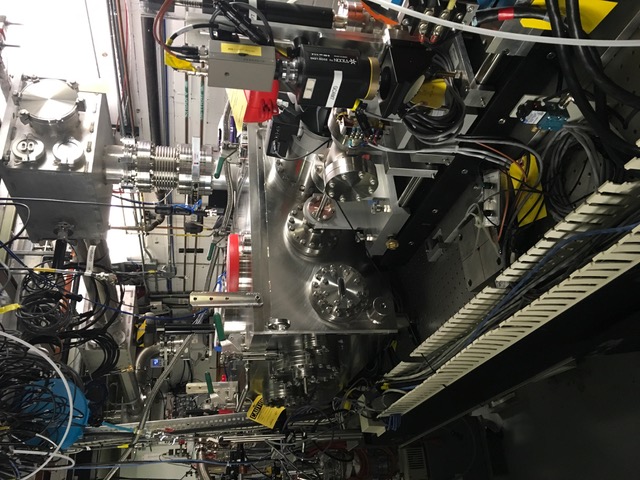Wakefield Accelerators: Miniaturized yet Powerful

Introduction
Wakefield Acceleration enables the miniaturization of accelerating structures by creating much higher-energy particles in the same footprint as the usual accelerators. There are only 5-10 universities in the USA that offer courses in this emerging field of Wakefield Acceleration. Stony Brook University is proud to be on this short list. This new concept will eventually usher in a new generation of compact accelerators and radiation sources. Equivalent sources of ultra-relativistic electrons, with miniaturized footprint, may one day be applied to high-energy colliders “to extend our understanding of the basic laws of [the] universe” according to the Plasma Science Report by the National Academies of Sciences, Engineering, and Medicine. In addition to fundamental physics research, applications of these electron sources include producing x-rays and gamma rays (currently equivalent to third-generation light sources) which will be a powerful enabling technology for medicine and industry
But what is Wakefield Acceleration?
A plasma is an ionized medium, meaning that the ions and electrons that are tightly bound together in ordinary matter, are free to move independently in response to electromagnetic forces. To generate waves in this medium, sources of intense electromagnetic energy such as lasers or ultra-relativistic electron beams are sent through plasma. Because the electrons are light, the forces of the intense driver expel the plasma electrons out of its path, leaving behind the much heavier ions, which are nearly stationary on the time scale of the interaction. The ions pull the electrons back towards the axis, where they overshoot, setting up an oscillating density wave behind the driver. The fields of this wave, which is set up in the wake of the intense driver, are referred to as wakefield.
Both laser-driven and particle beam-driven plasma waves have demonstrated average sustained accelerating forces of around 40 GeV/m, with laser-driven plasma waves producing electron beams of 8 GeV from 20 cm plasma channels, and electron-beam driven waves producing 33 GeV of energy from 130 cm plasma. For comparison, an advanced conventional accelerator such as LCLS at SLAC National Laboratory produces a beam with similar energy (10 GeV) over 1 km. Unlike regular accelerating structures made of copper that are damaged when the fields exceed around 100 MeV/m, plasma wakes can support 100 GeV/m (1000x) in conditions that are relatively easy to achieve.
While the high fields within the plasma waves have been experimentally used to generate GeV-scale beams, generating particle beams with properties suitable for applications remains a significant challenge. There is intense work within the field of plasma-based accelerators to improve the quality of the generated beams in order to realize the promise of compact, bright particle and radiation beams for transformative applications.
The Course
The course, PHY694 Plasma and Wakefield Accelerators, starts with the physics of single particle motion in the fields of intense laser and particle beams. The class then contains about three weeks of general introduction to plasma physics itself and the formalism used for modeling waves in plasma. Next, a series of lectures investigate the physics of plasma wave excitation in increasing layers of complexity, starting from 1D linear waves, and building up to fully 3D nonlinear wakefields. The students then learn about the characterization of the electron beams injected in these plasma wakefields, including the study of energy spread, and emittance.
The course material is delivered through regular class lectures. The learning is reinforced through homework and simulation studies, facilitated by Jupyter notebooks, where students learn the properties of wakefield by manipulating various plasma and driver parameters. The final project for the class consists of conducting several simulations to study the effect of particular parameters in the simulations.
The class was offered for the first time in 2022, and will be offered about once every two years. Ten students participated in the inaugural class.
The Instructor
The instructor in the course is Prof. Vafaei-Najafabadi who received his PhD from UCLA in 2016, after which he joined the Physics and Astronomy Department at Stony Brook University.
He has participated in the plasma-based acceleration research through collaborations with leading laser and particle beam facilities in the US. Currently, he has active experimental projects with Brookhaven National Laboratory, SLAC National Accelerator Laboratory, and the Laboratory for Laser Energetics at University of Rochester. He has contributed to over 30 referred journal publications, including six in the leading Nature family of publications (one as a cover on Nature). In 2019, he become facility scientist at the Accelerator Test Facility (ATF) of BNL, where he plays a primary role in setting the research direction at the facility.
When asked if some students go onto work on wakefield acceleration, Prof. Vafaei-Najafabadi says “Definitely! Students can participate in plasma wakefield acceleration through experiments at multiple national labs, including through work with my group at the Accelerator Test Facility at BNL.”
